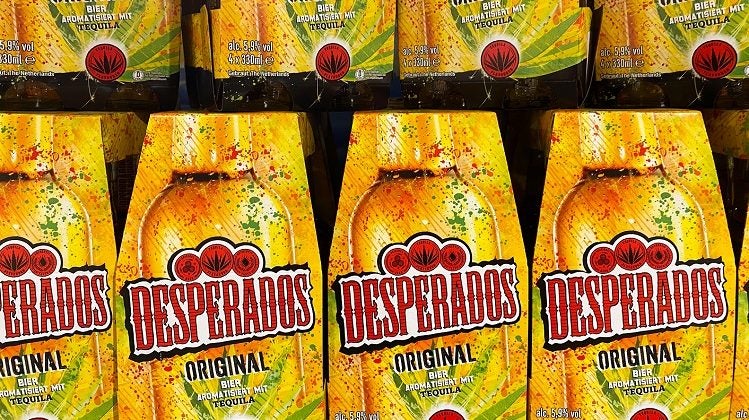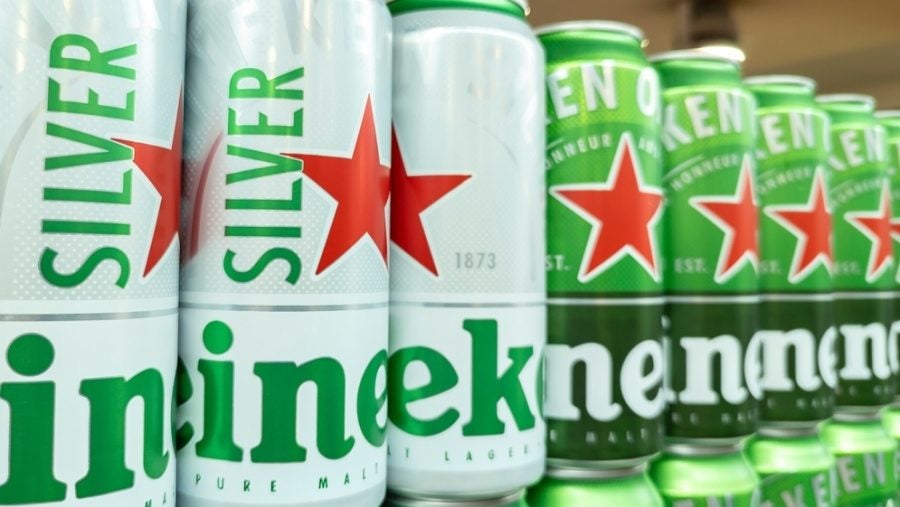“We delivered a solid first half of the year,” Heineken CEO and chairman Dolf van den Brink told investors and analysts yesterday (29 July) as he presented the brewer’s first-half results.
By the end of the day, shares in the Dutch giant had fallen 9.7% on Friday’s closing trading price as the market reacted to an impairment in China, group beer volumes in the first half that missed analyst forecasts and changes to the company’s 2024 guidance that also fell short of their (consensus) expectations.
“Overall, following a decent Q1, this print will do little to improve investors’ belief that they can sleep easy at night whilst owning Heineken,” Barclays analyst Laurence Whyatt wrote in a note to clients.
Heineken talks up China performance amid impairment
Heineken included a hefty impairment charge on its business in China in its first-half accounts.
The Amstel brewer posted a group half-year loss of €95m ($102.9m) after writing down the value of its stake in Chinese brewer CR Beer. The move led to an impairment charge of €874m.
Heineken holds 40% of CRH (Beer) Limited (CBL) after a deal struck in 2019. CBL in turn owns a controlling interest of 51.67% in the Hong Kong-listed China Resources Beer (Holdings) Co. Ltd (also known as CR Beer). As a consequence, Heineken has an effective 20.67% economic interest in CR Beer.
In Heineken’s results statement today, the group said the fair value of its investment in CR Beer, based on the share price, was below its cost as of 31 December 2023.
However, it said on 30 June, “a significant decline in the fair value of the investment below its cost was identified”.
Heineken pointed to trading conditions in China. “The decline was driven by concerns on the macroeconomic environment in China and a negative view on consumer goods companies seen as more exposed to soft consumer demand,” it said.
The brewer did say the volumes of Heineken-branded beer it sold in China in the first half of 2024 were “up more than 25%”.
H1 beer volumes miss expectations
Heineken’s group beer volumes rose 2.1% in the first half on an organic basis, driven by a 9.2% rise in volumes of its namesake branded products. The brewer, which also markets brands including Birra Moretti, Tiger and Edelweiss, said volumes of its “premium” beer were up 5%.
The group said it saw “all regions contributing” to its volume performance, pointing out that it “gained or held market share in more than half of our markets”.
Nevertheless, Heineken acknowledged its volume growth was “slower” in the second quarter than in the opening three months of the year. It cited the change in when Easter fell this year versus 2023, stiffer competition in the “economy segment” in Brazil and “poor weather” in June in Europe.
However, the consensus forecast among analysts for Heineken’s group beer volumes was for growth of 3.4% on an organic basis.
Speaking to analysts, van den Brink reflected on the “disruption” wrought by Covid-19 and then input-cost inflation and said Heineken’s “number one priority” had been to “normalise our top line and rebalance it between volume and revenue per hectolitre”.
He added: “We’re pleased at the half-year mark to see that normalisation starting to take place, with a good volume growth – 2.1% – [and] 4%-plus revenue per hectolitre [growth], positive in all regions.”
Europe in the spotlight
Heineken faced questions about the performance of its business in Europe during the first half.
The brewer’s volumes in Europe were flat at 38 million hectolitres, although it pointed to a 3.6% increase in Heineken-branded volumes on an organic basis. By contrast, Europe is the largest market for Desperados and the brand saw its volumes in the region decline.

The group net revenue Heineken generated in Europe declined 1.1% organically to €5.91bn. Europe remains the largest revenue generator for Heineken but it was the only region in which the group saw its half-year revenues fall.
Moreover, Heineken’s European business generated an underlying operating profit of €614m, up only 0.2% on the year. “The main miss came in Europe with 0.2% profit growth as the company was impacted by adverse channel mix and increased promotional activities in a more competitive market,” Whyatt said, pointing out that the consensus among analysts was for growth of more than 15%.
On the analyst call after the results were published, Heineken’s management faced questions about the promotional environment in Europe and the margins the group believed it could generate from the business there.
Reflecting on the period, van den Brink said by the end of May Heineken’s group volumes were “actually up significantly more” than the H1 out-turn but the weather in June “had a disproportionate impact”.
He added: “Towards the end of the second quarter you saw indeed more promotional pressure but that was also we think related to all the sports activity and either way going into summer that's a normal pattern.
“And even though we are somewhat disappointed about the start of the summer, assuming normal weather for the remainder of the summer and the rest of the year, we continue to aim for a positive volume effect in the year with modest pricing.”
On Heineken’s European margins, CFO Harald van den Broek said the group’s investment in marketing in June, combined with the month’s poor weather in the north-west of the region hitting the more profitable on-trade, affected its profitability. “The combination of those two really make that flat operating margin for the first half of the year. Not what we aspired for; it is definitely what we got,” he said. “Underlying, we don't believe that there is structurally an issue with our profitability in Europe.”
Heineken’s guidance falls flat
First-half revenue was up 2.2% at €17.82bn. Underlying net revenue rose 6%, compared to analyst forecasts of 7.7% growth.
Reported operating profit fell 4.3% to €1.54bn but, on an underlying basis, grew 12.5% to €2.08bn.
Underlying net profit rose 4.4% to €1.2bn.
Alongside the half-year results, Heineken also raised its forecasts for its adjusted organic operating profit and adjusted organic net profit for 2024.
However, the new guidance for the operating profit metric was still lower than the consensus among analysts covering Heineken.
Heineken now sees its adjusted organic operating profit growing by 4-8% in 2024.
The brewer predicts its adjusted organic net profit will rise “more closely in line” with the expected growth in underlying operating profit.
In April, Heineken had forecast its adjusted organic operating profit would grow “by a low- to high-single-digit” this year. It said then it expected its adjusted organic net profit would rise at a slower rate than the operating profit metric.
“The new EBIT guidance of 4-8% growth is underwhelming and is below where current forecasts are,” Whyatt at Barclays wrote, noting that the consensus forecast stood at growth of 8.2%. “This set of results has not achieved the new aim of management to ‘be more boring’.”
The guidance contributed to the tumble in Heineken’s share price yesterday, which has inched back up 1.3% today on yesterday’s level to €82.56 at 14:30 CEST.
At Bernstein, Trevor Stirling thought the market’s reaction was overdone.
“A guidance upgrade was expected and many expected more. With consensus already at the top-end of the new 4-8% [range], narrowing the bottom-end had limited impact,” he wrote. “Management prefer to spend any upside to +8% on even more A&P. However, for the stock to fall 10% on (at worst) low-single-digit percentage consensus EPS revisions does not make sense.”
He added: “A&P reinvestment does remove the potential for a short-term beat but the share price reaction seems to imply it will all be wasted.
“In our view, nothing fundamental has changed in the equity story. Heineken’s growth footprint is best-in-class, and their premium brands are delivering. Reinvesting in volume growth is normally celebrated by the market (especially, if margins are also up) and there is still a lot of upside from self-help in the European manufacturing footprint and rationalising the IT backbone.”









